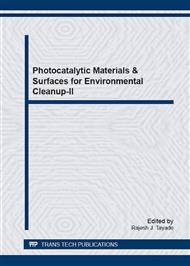[1]
Q. R. Deng, X. H. Xia, M. L. Guo, Y. Gao, and G. Shao, Mn-doped TiO2 nanopowders with remarkable visible light photocatalytic activity, Materials Letters, vol. 65, no. 13, p.2051–2054, Jul. (2011).
DOI: 10.1016/j.matlet.2011.04.010
Google Scholar
[2]
Y. J. Kim, H. J. Kwon, I. -S. Nam, J. W. Choung, J. K. Kil, H. -J. Kim, M. -S. Cha, and G. K. Yeo, High deNOx performance of Mn/TiO2 catalyst by NH3, Catalysis Today, vol. 151, no. 3–4, p.244–250, (2010).
DOI: 10.1016/j.cattod.2010.02.074
Google Scholar
[3]
V. C. Papadimitriou, V. G. Stefanopoulos, M. N. Romanias, P. Papagiannakopoulos, K. Sambani, V. Tudose, and G. Kiriakidis, Determination of photo-catalytic activity of un-doped and Mn-doped TiO2 anatase powders on acetaldehyde under UV and visible light, Thin Solid Films, vol. 520, no. 4, p.1195–1201, (2011).
DOI: 10.1016/j.tsf.2011.07.073
Google Scholar
[4]
L. Laokiat, P. Khemthong, and N. Grisdanurak, Electronic Chemical Properties of Vanadium Doped TiO2 for Photocatalytic Degradation of BTEX, Materials Science Forum, vol. 700, p.223–226, Sep. (2011).
DOI: 10.4028/www.scientific.net/msf.700.223
Google Scholar
[5]
C. J. E. Bajamundi, M. L. P. Dalida, K. Wantala, P. Khemthong, and N. Grisdanurak, Effect of Fe3+ doping on the performance of TiO2 mechanocoated alumina bead photocatalysts, Korean Journal of Chemical Engineering, vol. 28, no. 8, p.1688–1692, (2011).
DOI: 10.1007/s11814-011-0031-7
Google Scholar
[6]
K. Wantala, L. Laokiat, P. Khemthong, N. Grisdanurak, and K. Fukaya, Calcination temperature effect on solvothermal Fe-TiO2 and its performance under visible light irradiation, Journal of the Taiwan Institute of Chemical Engineers, vol. 41, no. 5, p.612–616, (2010).
DOI: 10.1016/j.jtice.2010.01.008
Google Scholar
[7]
K. Wantala, D. Tipayarom, L. Laokiat, and N. Grisdanurak, Sonophotocatalytic activity of methyl orange over Fe(III)/TiO2, Reaction Kinetics and Catalysis Letters, vol. 97, no. 2, p.249–254, Jul. (2009).
DOI: 10.1007/s11144-009-0045-x
Google Scholar
[8]
K. Wantala, P. Khemthong, J. Wittayakun, and N. Grisdanurak, Visible light-irradiated degradation of alachlor on Fe-TiO2 with assistance of H2O2, Korean Journal of Chemical Engineering, vol. 28, no. 11, p.2178–2183, (2011).
DOI: 10.1007/s11814-011-0095-4
Google Scholar
[9]
R. J. Tayade, R. G. Kulkarni, and R. V. Jasra, Transition Metal Ion Impregnated Mesoporous TiO2 for Photocatalytic Degradation of Organic Contaminants in Water, Ind. Eng. Chem. Res., vol. 45, no. 15, p.5231–5238, (2006).
DOI: 10.1021/ie051362o
Google Scholar
[10]
R. J. Tayade, H. C. Bajaj, and R. V. Jasra, Photocatalytic removal of organic contaminants from water exploiting tuned bandgap photocatalysts, Desalination, vol. 275, no. 1–3, p.160–165, Jul. (2011).
DOI: 10.1016/j.desal.2011.02.047
Google Scholar
[11]
I. A. Alaton, I. A. Balcioglu, and D. W. Bahnemann, Advanced oxidation of a reactive dyebath effluent: comparison of O3, H2O2/UV-C and TiO2/UV-A processes, Water Res., vol. 36, no. 5, p.1143–1154, Mar. (2002).
DOI: 10.1016/s0043-1354(01)00335-9
Google Scholar
[12]
L. G. Devi, S. G. Kumar, B. N. Murthy, and N. Kottam, Influence of Mn2+ and Mo6+ dopants on the phase transformations of TiO2 lattice and its photo catalytic activity under solar illumination, Catalysis Communications, vol. 10, no. 6, p.794–798, Feb. (2009).
DOI: 10.1016/j.catcom.2008.11.041
Google Scholar
[13]
Z. Zhang and H. Zheng, Optimization for decolorization of azo dye acid green 20 by ultrasound and H2O2 using response surface methodology, Journal of Hazardous Materials, vol. 172, no. 2–3, p.1388–1393, (2009).
DOI: 10.1016/j.jhazmat.2009.07.146
Google Scholar
[14]
K. Wantala, E. Khongkasem, N. Khlongkarnpanich, S. Sthiannopkao, and K. -W. Kim, Optimization of As(V) adsorption on Fe-RH-MCM-41-immobilized GAC using Box-Behnken Design: Effects of pH, loadings, and initial concentrations, Applied Geochemistry, vol. 27, no. 5, p.1027–1034, (2012).
DOI: 10.1016/j.apgeochem.2011.11.014
Google Scholar


